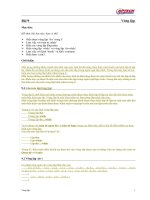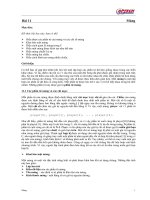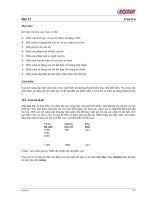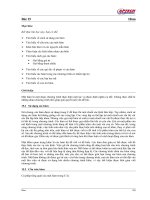Computer concept 2018 module11
Bạn đang xem bản rút gọn của tài liệu. Xem và tải ngay bản đầy đủ của tài liệu tại đây (2.01 MB, 91 trang )
Computer Concepts 2018
Module 11
Programming
© 2019 Cengage. All rights reserved.
Module Contents
•
•
•
•
•
Section A: Program Development
Section B: Programming Tools
Section C: Procedural Programming
Section D: Object-Oriented Programs
Section E: Declarative Programming
© 2019 Cengage. All rights reserved.
Section A: Program Development
•
•
•
•
Programming Basics
Program Planning
Writing Programs
Program Testing and Documentation
© 2019 Cengage. All rights reserved.
Section A: Objectives (1 of 2)
• Describe the difference between programming and
software engineering
• List the three core elements of a problem statement and
provide an example of each
• Supply at least three examples of projects that would be
best tackled using predictive methodology and three
projects best tackled using agile methodology
• Describe the difference between constants and
variables, and provide an example of how each would
be used in a program
© 2019 Cengage. All rights reserved.
Section A: Objectives (2 of 2)
• List three types of errors that might be encountered
during program testing
• Explain the significance of formal methods
• Explain the purpose of STRIDE and DREAD
• Explain the significance of defensive programming
© 2019 Cengage. All rights reserved.
Programming Basics (1 of 3)
• Computer programming encompasses a broad set
of activities that include planning, coding, testing, and
documenting
• A related activity, software engineering, is a
development process that uses mathematical,
engineering, and management techniques to reduce
the cost and complexity of a computer program while
increasing its reliability and modifiability
• Software engineering can be characterized as more
formalized and rigorous than computer programming
© 2019 Cengage. All rights reserved.
Programming Basics (2 of 3)
© 2019 Cengage. All rights reserved.
Programming Basics (3 of 3)
• Programmers typically specialize in either application
programming or system development
• Application programmers create productivity
applications such as Microsoft Office
• Systems programmers specialize in developing
system software such as operating systems, device
drivers, security modules, and communications software
© 2019 Cengage. All rights reserved.
Program Planning (1 of 3)
• In the context of programming, a problem statement
defines certain elements that must be manipulated to
achieve a result or goal
• A good problem statement for a computer program has
three characteristics:
– It specifies any assumptions that define the scope of the
problem
– It clearly specifies the known information
– It specifies when the problem has been solved
© 2019 Cengage. All rights reserved.
Program Planning (2 of 3)
• In a problem statement, an assumption is something
you accept as true in order to proceed with program
planning
• The known information in a problem statement is the
information that is supplied to the computer to help it
solve a problem
• After identifying the known information, a programmer
must specify how to determine when the problem has
been solved
© 2019 Cengage. All rights reserved.
Program Planning (3 of 3)
• Several software development methodologies exist to
help program designers and coders plan, execute, and
test software
• Methodologies can be classified as predictive or agile
– A predictive methodology requires extensive planning
and documentation up front; it’s used to construct
buildings and assemble cars—tasks that are well defined
and predictable
– An agile methodology focuses on flexible development
and specifications that evolve as the project progresses
© 2019 Cengage. All rights reserved.
Program Coding (1 of 6)
• The core of a computer program is a sequence of
instructions
• A keyword, or command, is a word with a predefined
meaning
• Keywords differ depending on the programming
language; there is a basic vocabulary that covers most
necessary tasks
© 2019 Cengage. All rights reserved.
Program Coding (2 of 6)
input
Collection information from the program’s user.
Display information on the screen.
while
Begin a series of commands that will be repeated in a loop.
break
Terminate a loop.
if
Execute one or more instructions only if a specified
condition is true.
else
Add more options to extend the if command.
def
Define a series of instructions that become a unit called a
function.
return
Transfer data from a function to some other part of the
program.
class
Define an object as a set of attributes and methods.
© 2019 Cengage. All rights reserved.
Program Coding (3 of 6)
• Keywords can be combined with specific parameters,
which provide more detailed instructions for the
computer to carry out
• These parameters include variables and constants
– A variable represents a value that can change
– A constant is a factor that remains the same throughout
a program
© 2019 Cengage. All rights reserved.
Program Coding (4 of 6)
• The set of rules that specify the sequence of keywords,
parameters, and punctuation in a program instruction is
referred to as syntax
© 2019 Cengage. All rights reserved.
Program Coding (5 of 6)
• You may be able to use a text editor, program editor, or
graphical user interface to code computer programs
• A text editor is any word processor that can be used for
basic text editing tasks, such as writing email, creating
documents, and coding computer programs
• A program editor is a type of text editor specially
designed for entering code for computer programs
• A VDE (visual development environment) provides
programmers with tools to build substantial sections of a
program by pointing and clicking rather than typing each
statement
© 2019 Cengage. All rights reserved.
Program Coding (6 of 6)
• Frequently used controls include labels, menus,
toolbars, list boxes, text boxes, option buttons, check
boxes, and graphical boxes
• A control can be customized by specifying values for a
set of built-in properties
© 2019 Cengage. All rights reserved.
Program Testing and Documentation
(1 of 9)
• Programs that don’t work correctly might crash, run
forever, or provide inaccurate results; when a program
isn’t working, it’s usually the result of a runtime, logic, or
syntax error
– A runtime error occurs when a program runs instructions
that the computer can’t execute
– A logic error is a type of runtime error in the logic or
design of the program
– A syntax error occurs when an instruction does not
follow the syntax rules of the programming language
© 2019 Cengage. All rights reserved.
Program Testing and Documentation
(2 of 9)
•
•
•
•
•
Omitting a keyword, such as
ELSE
Misspelling a keyword, such as
mistakenly typing PIRN instead of
Omitting required punctuation,
such as a period, comma, or
bracket
Using incorrect punctuation, such
as typing a colon where a
semicolon is required
Forgetting to close parentheses
© 2019 Cengage. All rights reserved.
Program Testing and Documentation
(3 of 9)
• The process of finding and fixing errors in a computer
program is called debugging
• Programmers can locate errors in a program by reading
through each line, much like a proofreader
• Programmers also insert documentation called remarks
(or comments) into the program
© 2019 Cengage. All rights reserved.
Program Testing and Documentation
(4 of 9)
• Programs need to meet performance, usability, and
security standards
– Performance – programmers need to carry out real-world
tests to ensure that programs don’t take too long to load
– Usability – programs should be easy to learn and use
and be efficient
– Security – program specifications are formulated so that
programmers remain aware of security throughout the
software development life cycle
© 2019 Cengage. All rights reserved.
Program Testing and Documentation
(5 of 9)
• Formal methods help programmers apply rigorous
logical and mathematical models to software design,
composition, testing, and verification
• Threat modeling (also called risk analysis) is a
technique that can be used to identify potential
vulnerabilities by listing the key assets of an application,
categorizing the threats to each asset, ranking the
threats, and developing threat mitigation strategies that
can be implemented during programming
© 2019 Cengage. All rights reserved.
Program Testing and Documentation
(6 of 9)
• Spoofing: Pretending to be someone else
• Tampering: Changing, adding, or deleting data
• Repudiation: Covering tracks to make attacks difficult to
trace
• Information disclosure: Gaining unauthorized access to
information
• Denial of service: Making a system unavailable to
legitimate users
• Elevation of Privilege: Modifying user rights to gain
access to data
© 2019 Cengage. All rights reserved.
Program Testing and
Documentation (7 of 9)
• Damage: How much damage can a particular attack
cause?
• Reproduce: Is this attack easy to reproduce?
• Exploit: How much skill is needed to launch the attack?
• Affected: How many users would be affected by an
attack?
• Discovered: How likely is it that this attack would be
discovered?
© 2019 Cengage. All rights reserved.
Program Testing and Documentation
(8 of 9)
• Defensive programming (also referred to as secure
programming) is an approach to software development
in which programmers anticipate what might go wrong
as their programs run and take steps to smoothly
handle those situations
• Techniques associated with defensive programming
include:
– Walkthroughs. Open source software goes through
extensive public scrutiny that can identify security holes,
but proprietary software can also benefit from a
walkthrough with other in-house programmers
© 2019 Cengage. All rights reserved.









